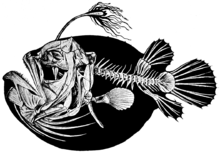Himantolophus
| Footballfish | |
|---|---|
 |
|
| Himantolophus groenlandicus | |
| Scientific classification | |
| Kingdom: | Animalia |
| Phylum: | Chordata |
| Class: | Actinopterygii |
| Order: | Lophiiformes |
| Family: | Himantolophidae |
| Genus: |
Himantolophus J. C. H. Reinhardt, 1837 |
| Species | |
|
|
|
The footballfish form a family, Himantolophidae, of globose, deep-sea anglerfishes found in tropical and subtropical waters of the Atlantic, Indian, and Pacific Ocean. The family contains c. 19 species all in a single genus, Himantolophus (from the Greek imantos, "thong, strap", and lophos, "crest").
As in other deep-sea anglerfish families, sexual dimorphism is extreme: the largest females may exceed lengths of 60 cm (two feet) and are globose in shape, whereas males do not exceed 4 cm (1.5 inches) as adults and are comparatively fusiform. Their flesh is gelatinous, but thickens in the larger females, which also possess a covering of "bucklers" — round, bony plates each with a median spine — that are absent in males. Both are a reddish brown to black in life.
In females, the mouth is large and oblique. The subequal jaws are anteriorly lined with rows of numerous close-set, depressible, and retrorse teeth; vomerine teeth are absent. Footballfish females differ from those of other ceratioid families by their shortened, blunt snout; along with the chin, it is covered in sensory papillae. Originating above or slightly in advance of the small eye is an ilicium (the "fishing rod") and at its end a bioluminescent, bulbous esca (the "fishing lure", its light owing to symbiotic bacteria). Escal morphology varies between species, and it may or may not possess denticles or accessory appendages, the latter either branched or unbranched. The pterygiophore of the ilicium does not protrude from the snout, and there is no hyoid barbel.
...
Wikipedia
